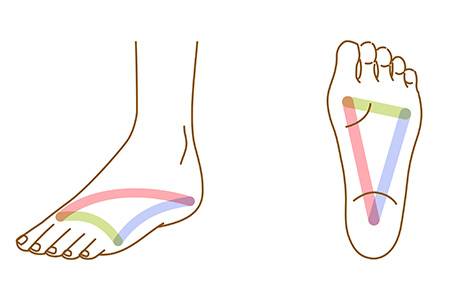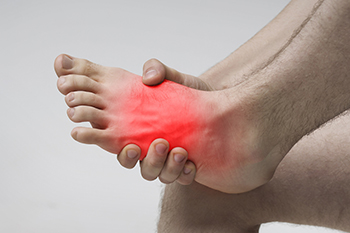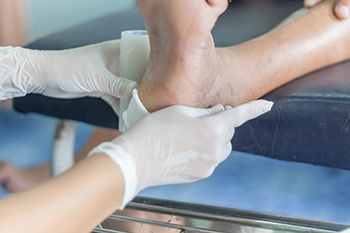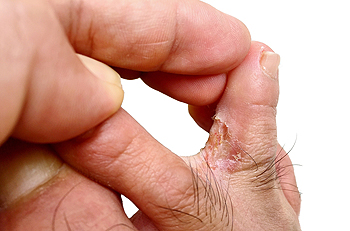Connect With Us
Blog
Items filtered by date: August 2025
Wounds That Don't Heal Need to Be Checked
Foot Arch Types and How to Support Them

Foot arches play a vital role in balance, movement, and shock absorption. There are three main types, which are high arches, or pes cavus, flat feet, also called pes planus, and normal arches. Each type affects how the foot functions and bears weight. Weak or imbalanced arches can lead to discomfort or injury. Arch strengthening exercises such as arch lifts, heel raises, and towel pickups can help improve stability and support. A podiatrist can assess your arch type, recommend custom orthotics, and guide you through exercises tailored to your needs. If you experience foot fatigue, imbalance, or pain, it is suggested that you seek professional help from a podiatrist who can guide you on a custom plan to strengthen your arches and promote long-term foot health and comfort.
Exercising your feet regularly with the proper foot wear is a great way to prevent injuries and build strength. If you have any concerns about your feet, contact Paul Hutchison, DPM from Hutchison Foot Clinic. Our doctor can provide the care you need to keep you pain-free and on your feet.
Exercise for Your Feet
Exercise for your feet can help you gain strength, mobility and flexibility in your feet. They say that strengthening your feet can be just as rewarding as strengthening another part of the body. Your feet are very important, and we often forget about them in our daily tasks. But it is because of our feet that are we able to get going and do what we need to. For those of us fortunate enough to not have any foot problems, it is an important gesture to take care of them to ensure good health in the long run.
Some foot health exercises can include ankle pumps, tip-toeing, toe rises, lifting off the floor doing reps and sets, and flexing the toes. It is best to speak with Our doctor to determine an appropriate regimen for your needs. Everyone’s needs and bodies are different, and the activities required to maintain strength in the feet vary from individual to individual.
Once you get into a routine of doing regular exercise, you may notice a difference in your feet and how strong they may become.
If you have any questions, please feel free to contact our office located in Memphis, TN . We offer the newest diagnostic and treatment technologies for all your foot care needs.
Why the Top of the Foot Can Hurt When Running

Pain in the top of your foot after running is often caused by inflammation of the tendons that are responsible for lifting and straightening your toes. This condition is known as extensor tendonitis. When these extensor tendons become inflamed, they can cause pain, particularly during activities like running. Factors that contribute to top of the foot pain include overuse, tight calf muscles, or having flat feet, which can place additional strain on the tendons. Wearing shoes that are too tight or poorly fitted may also increase the risk. Pain from extensor tendonitis is typically felt along the top of the foot, often near the shoelaces, and can be accompanied by swelling and a bump on the tendon. If you experience top of the foot pain after running, it is suggested that you schedule an appointment with a podiatrist for a diagnosis and appropriate treatment.
Foot Pain
Foot pain can be extremely painful and debilitating. If you have a foot pain, consult with Paul Hutchison, DPM from Hutchison Foot Clinic. Our doctor will assess your condition and provide you with quality foot and ankle treatment.
Causes
Foot pain is a very broad condition that could be caused by one or more ailments. The most common include:
- Bunions
- Hammertoes
- Plantar Fasciitis
- Bone Spurs
- Corns
- Tarsal Tunnel Syndrome
- Ingrown Toenails
- Arthritis (such as Gout, Rheumatoid, and Osteoarthritis)
- Flat Feet
- Injury (from stress fractures, broken toe, foot, ankle, Achilles tendon ruptures, and sprains)
- And more
Diagnosis
To figure out the cause of foot pain, podiatrists utilize several different methods. This can range from simple visual inspections and sensation tests to X-rays and MRI scans. Prior medical history, family medical history, and any recent physical traumatic events will all be taken into consideration for a proper diagnosis.
Treatment
Treatment depends upon the cause of the foot pain. Whether it is resting, staying off the foot, or having surgery; podiatrists have a number of treatment options available for foot pain.
If you have any questions, please feel free to contact our office located in Memphis, TN . We offer the newest diagnostic and treatment technologies for all your foot care needs.
Understanding Non Diabetic Foot Ulcers

Foot ulcers are not only a concern for people with diabetes. Many individuals without diabetes also develop painful sores on the feet that are slow to heal. These ulcers can be caused by poor circulation, vein problems, pressure from footwear, or unnoticed injuries. People with limited mobility, nerve damage, or skin conditions are especially at risk. Unlike diabetic foot ulcers, these wounds may be overlooked or misdiagnosed, delaying proper treatment. If left untreated, they can lead to infection and deeper tissue damage. Identifying the root cause is essential to healing. A podiatrist can evaluate the ulcer, recommend wound care, and help prevent future sores. If you notice a sore on your foot that is not healing or keeps returning, it is suggested that you schedule an appointment with a podiatrist for an evaluation and expert care.
Wound care is an important part in dealing with diabetes. If you have diabetes and a foot wound or would like more information about wound care for diabetics, consult with Paul Hutchison, DPM from Hutchison Foot Clinic. Our doctor will assess your condition and provide you with quality foot and ankle treatment.
What Is Wound Care?
Wound care is the practice of taking proper care of a wound. This can range from the smallest to the largest of wounds. While everyone can benefit from proper wound care, it is much more important for diabetics. Diabetics often suffer from poor blood circulation which causes wounds to heal much slower than they would in a non-diabetic.
What Is the Importance of Wound Care?
While it may not seem apparent with small ulcers on the foot, for diabetics, any size ulcer can become infected. Diabetics often also suffer from neuropathy, or nerve loss. This means they might not even feel when they have an ulcer on their foot. If the wound becomes severely infected, amputation may be necessary. Therefore, it is of the upmost importance to properly care for any and all foot wounds.
How to Care for Wounds
The best way to care for foot wounds is to prevent them. For diabetics, this means daily inspections of the feet for any signs of abnormalities or ulcers. It is also recommended to see a podiatrist several times a year for a foot inspection. If you do have an ulcer, run the wound under water to clear dirt from the wound; then apply antibiotic ointment to the wound and cover with a bandage. Bandages should be changed daily and keeping pressure off the wound is smart. It is advised to see a podiatrist, who can keep an eye on it.
If you have any questions please contact our office located in Memphis, TN . We offer the newest diagnostic and treatment technologies for all your foot and ankle needs.
Athlete’s Foot Facts

Athlete’s foot is a fungal infection that affects the skin of the feet, often beginning between the toes. Symptoms include itching, burning, scaling, and cracked skin. It thrives in warm, moist environments such as locker rooms, communal showers, and sweaty footwear. Causes include walking barefoot in public places and wearing damp socks or shoes. Risk factors include poor foot hygiene, compromised immunity, and tight footwear. A podiatrist can confirm the diagnosis, recommend effective treatment, and provide tips to prevent recurrence. If you notice symptoms of athlete’s foot, it is suggested that you promptly consult a podiatrist who can offer effective relief and treatment tips.
Athlete’s foot is an inconvenient condition that can be easily reduced with the proper treatment. If you have any concerns about your feet and ankles, contact Paul Hutchison, DPM from Hutchison Foot Clinic. Our doctor will treat your foot and ankle needs.
Athlete’s Foot: The Sole Story
Athlete's foot, also known as tinea pedis, can be an extremely contagious foot infection. It is commonly contracted in public changing areas and bathrooms, dormitory style living quarters, around locker rooms and public swimming pools, or anywhere your feet often come into contact with other people.
Solutions to Combat Athlete’s Foot
- Hydrate your feet by using lotion
- Exfoliate
- Buff off nails
- Use of anti-fungal products
- Examine your feet and visit your doctor if any suspicious blisters or cuts develop
Athlete’s foot can cause many irritating symptoms such as dry and flaking skin, itching, and redness. Some more severe symptoms can include bleeding and cracked skin, intense itching and burning, and even pain when walking. In the worst cases, Athlete’s foot can cause blistering as well. Speak to your podiatrist for a better understanding of the different causes of Athlete’s foot, as well as help in determining which treatment options are best for you.
If you have any questions please feel free to contact our office located in Memphis, TN . We offer the newest diagnostic and treatment technologies for all your foot and ankle needs.

